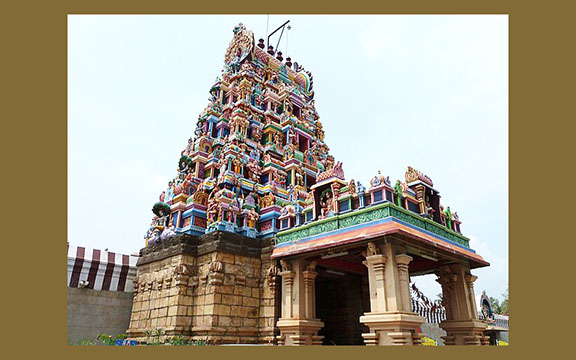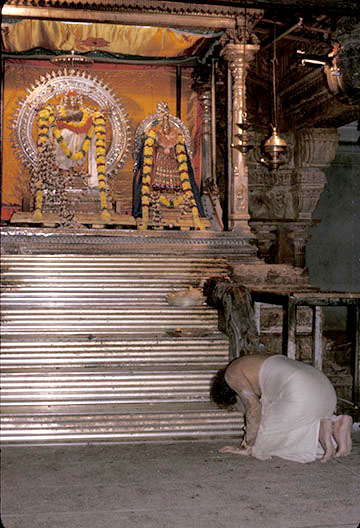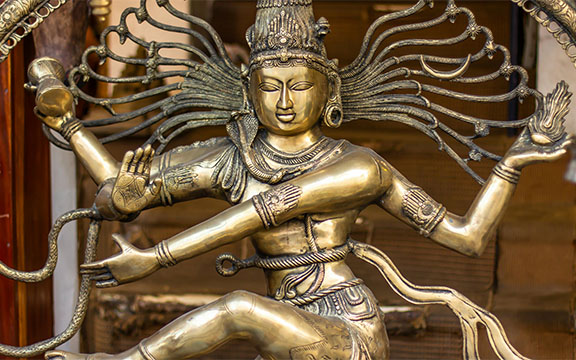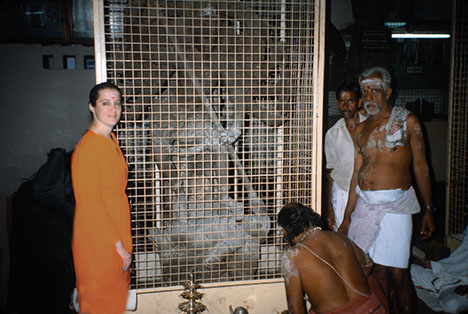
Photo: Arulmigu Patteeswaraswami Temple, Perur, South India.
When asked to reflect upon his life, Swami Satchidananda once said, “It’s hard to summarize a long life in a few words. But I can just say I am fortunate, in a way, to be born in a family of pious parents. They were my first Gurus. They instilled faith in God in my heart. And somehow from then on, I never worried about anything. Everything just fell into it proper places. Even while I was a little student, I always felt that God was guiding me. From school, I went into business. There, again, one after the other, I got my hands in everything. Jack of all, even today, master of none. Yes, yes, I got my hands into everything. Automobile engineering, electronic engineering, cinematography, agricultural field, and temple management. A little bit of everything, everything, everything. Then everything naturally dropped away, one after the other.”
Temple Manager: The Cosmic Dancer Beckons
One day, the trustees of the Arulmigu Patteeswaraswami Temple approached Sri Kalyanasundaram with an urgent request. “Do you think Ramaswamy (Swami Satchidananda’s birthname was Ramaswamy, Ramu for short) would take up the management of our temple? He seems to be the proper person for the job and we are in great need of such a manager. The previous manager has left.”
“Well, I really can’t answer for him. My son is in Ceylon studying certain technical matters.” Ramu had traveled to Ceylon (now Sri Lanka) to study welding techniques, a skill that was necessary for the production of the needed gas plants for the motor vehicle company his uncle Sri Krishnaswamy Gounder was expanding. Ramu had been working with his uncle but Ramu’s relatives were rather shocked that his parents had agreed to let him go, at the age of 20, to another country. He was the first member of his extended family to ever travel outside of India, where, at that time, even trips to North India were a rarity. His time in Sri Lanka would be a foreshadowing of a deep relationship he would forge with that country in the 1950s.
Ramu’s father told the temple trustees, “Probably, when he returns to India, he’ll want to go back to his business.” The trustees were persistent. The temple lands were large, consisting of two villages and all their acreage, and had been donated by the kings of India. They waited until Ramu returned and approached him directly. To Sri Kalyanasundaram’s surprise, Ramu agreed. He felt it was an opportunity to serve the Lord. “I’ll do it on a temporary basis,” he told them, “until you find someone to your liking who can replace me.”
Ramu was familiar with the Perur Temple. Since childhood, he had been very fond of its large murti (statue of a Hindu deity used in worship) of the Nataraja—the dancing Siva, arms raised gracefully to the side, one leg balanced in the air between steps.
Perur: A Sanctified Ancient Village
Nestled in the heart of Coimbatore, the ancient village of Perur stands as a beacon of spiritual and architectural grandeur, home to the revered Arulmigu Patteeswaraswami Temple dedicated to Lord Shiva. This sacred sanctuary, with origins tracing back to the 2nd century CE, has been lovingly shaped and enriched by various dynasties over the centuries, transforming it into a masterpiece of sculptural and architectural excellence.

Photo: Calf Patti with Shivalingam depicted in a stone carving.
The temple’s genesis is steeped in legend. It is said that Kamadhenu, the divine cow venerated across India, performed rituals to seek the blessings of Lord Shiva. In one such ritual, Kamadhenu poured her milk over a Shivalinga hidden within an anthill. Her playful calf, Patti, accidentally toppled the anthill, revealing the Shivalinga. An alarmed Kamadhenu sought forgiveness from Lord Shiva, who appeared before her and expressed his affection for the calf. He proclaimed that the site would be known as “Kamadhenupuram” and “Pattipuri,” after the divine cow and her calf, and that he would remain there as Patteswara, Lord of the sacred cows.
Adding to the temple’s mystique is the presence of a tamarind tree known as Piravapuli. This tree is believed to possess miraculous properties; its seeds do not germinate, symbolizing the promise of salvation and freedom from the cycle of rebirth for those who pray at the Temple. This unique aspect of the tamarind tree enhances the spiritual aura of the Arulmigu Patteeswaraswami Temple.
The Shivalinga, housed in the sanctum sanctorum, is said to bear the imprint of Kamadhenu’s hoof—a divine mark that has endured through time. This Shivalinga, believed to have been discovered following the calf’s playful act, was enshrined by the Chola monarch Karikala Cholan. Over time, the Chola, Hoysala, and Vijayanagara dynasties contributed to the temple’s architectural splendor, adding intricate carvings and statues.
The temple boasts numerous towers and mandapams adorned with ornate pillars. Among its highlights is the Golden Hall, built in the 17th century by Alagadri Nayaka of Madurai. This Hall, renowned for its exquisite beauty, features a gold-plated murti of Lord Nataraja, the form of Lord Shiva as the Cosmic Dancer, bestowing blessings upon sages Gowmuni and Pattimuni. The gopurams and pillars, adorned with elaborate sculptures, are quintessential examples of Dravidian architecture.
Approximately 400 years ago, Sri Shanthalinga Swamigal, a revered saint and author of four shastras, established a mutt (ashram) near the temple. This mutt, known as Sri Shanthalinga Mutt Perur, became a center for spiritual teachings and meditation, continuing the temple’s legacy of enlightenment and devotion. Swami Satchidananda’s relationship to this mutt and its pontiffs will become pivotal later on in this series. The Arulmigu Patteeswaraswami Temple at Perur is not just a monument of historical and architectural significance; it is a living testament to faith, legend, and divine grace, drawing pilgrims and devotees from all corners of the world.

Photo: Worshiping Sri Nataraja and Goddess Sivakami.
The Enrapturing Essence of Lord Nataraja
While Patteeswara, with his beloved consort Parvati, known as Panchanayaki (“five-eyed” One, due to her all-seeing, omniscient qualities), are the presiding deities of this temple, Lord Nataraja and Sivakami (another form of Parvati, “beloved of Shiva”) are the presiding deities in the Kanaka Sabha (Golden Hall). It is in this Hall, that Ramu passed many nights enraptured while worshiping Nataraja. You may recall from Part 1 in this series, that six generations prior, his family’s relative Kuttiappa had been meditating in a Muruga temple when he was instructed to go to Arulmigu Patteeswaraswami Temple at Perur. There, he undertook a penance, allowing himself to be buried in an underground pit, remaining in the superconscious state of samadhi for forty-eight days.
Ramu also had many mystical experiences as he worshiped this deity. When all the devotees had left the Temple after the final evening prayers, he would decorate the image of Lord Nataraja with all the ornaments in his charge, light the lamps and spend the night in meditation before the flickering flames and this beloved form of God. In the 1990s, and again, in his last years, Swami Satchidananda would disclose the special role that Lord Nataraja played in his life.
To gain a deeper and more profound understanding of the symbolism of the Nataraja, it is essential to move beyond seeing it as merely a “statue.” When the British colonized India, they misinterpreted the veneration of these sacred images as “idol worship,” failing to grasp the intricate rituals that breathe life into these statues. Through the installation of mantras, a mere statue transforms into a murti—a living, breathing embodiment of the Divine. These mantras imbue the murti with life, and the daily rituals performed by priests—such as feeding, bathing, and putting the deity to rest—are actually nourishing the mantras within.
Nataraja, depicting Lord Shiva as the Cosmic Dancer, is a profound symbol in Hinduism, rich with layers of meaning. His dance, known as the Ananda Tandava or Dance of Bliss, encapsulates the cosmic processes of creation, preservation, dissolution, concealing, and revealing. This divine dance takes place within a ring of flames, the prabha mandala, symbolizing the cyclical nature of existence and the passage of time.
The Five Acts of Cosmic Dance
- Srishti (Creation): Represented by the drum (damaru) in Nataraja’s upper right hand, producing the primordial sound of creation.

Photo: Sri Nataraja at Kailash, Yogaville.
- Sthiti (Preservation): Symbolized by the abhaya mudra (gesture of fearlessness) in his lower right hand, offering protection and support to devotees.
- Samhara (Dissolution): Depicted by the flame of destruction (agni) in his upper left hand.
- Tirobhava (Illusion): Represented by the dwarf demon Apasmara under Nataraja’s right foot, symbolizing ignorance and the veiling of reality.
- Anugraha (Release from Illusion): Indicated by his lower left hand pointing towards his raised left foot, showing the path to liberation (moksha).
Symbolism of Lord Nataraja’s Form
- Four Arms: Represent Nataraja’s omnipotence and his ability to perform multiple cosmic functions simultaneously.
- Three Eyes: Symbolize the sun, moon, and transcendental knowledge (jnana netra).
- Crescent Moon: Signifies beauty and the measurement of time.
- Flowing Locks: Contain the goddess Ganga, representing abundance and prosperity.
- Cobra: Coiled around his arm, symbolizes kundalini energy and the conquest of fear.
- Earrings: Different in each ear (male in right, female in left), representing the unity of Shiva/Shakti—the embodiment of the inseparable masculine and feminine principles.
Philosophical and Scientific Interpretations
The dance of Nataraja embodies the balance of opposites: creation and destruction, male and female, and other dualities. Some scholars, like Fritjof Capra, have drawn parallels between Nataraja’s dance and the dynamic nature of subatomic particles in quantum physics. This connection underscores the image’s relevance in both ancient wisdom and modern scientific thought. The Nataraja image transcends duality, symbolizing the triumph over ignorance and the realization of ultimate truth.
Esoteric Meanings
- Inner Awakening: The dance signifies the awakening of kundalini energy within the human body.
- Spiritual Evolution: Each element of Nataraja’s iconography represents a stage in spiritual growth and Self-realization.
- Cosmic Consciousness: Nataraja embodies Being, Consciousness, and Bliss (Sat-chid-ananda), aligning with Advaita (nondual) philosophy.
The image of Nataraja is a complex, multifaceted symbol that encompasses cosmology, philosophy, artistry, and spirituality. It continues to inspire devotees, artists, and thinkers alike, bridging ancient wisdom with modern interpretations, and standing as a powerful emblem of cosmic harmony and spiritual enlightenment.
The Five Acts of Our Inner Divinity

Sri Nataraja, photo by Jaiju Jacob via Pexels.
How can we relate the rich symbolism embodied by the form of the Divine as the Nataraja to our lives? In the tapestry of our everyday lives, we embody the roles of creators, sustainers, dissolvers, concealers, and revealers. Christopher Hareesh Wallis, a scholar/practitioner of Shaiva Yoga once explained that, “Each action we take, each thought we nurture, and each relationship we build falls into one of these profound categories. Our lives are filled with creative events, both constructive and destructive: we create narratives that cause suffering, but we also create art, love, and meaningful connections. Every creation is an expression of the Divine energy. Reflect on all the ways you are a creator in your life.”
As sustainers, we nourish ourselves and others through our habits, interactions, and relationships. We maintain the patterns that define our daily existence. However, as dissolvers, we possess the power to recognize and dismantle the behaviors and interpretations that no longer serve us. Often, we may sustain a pattern of behavior we wish to change without realizing how detrimental it has become. As we progress on the spiritual path, when we reach the point of recognizing how we can dissolve these patterns, we can embrace the natural flow or spanda of life’s five acts. This dissolution is most psychospiritually healthy when we can view our actions from a place of loving awareness, free from judgment.
On our journey, we often conceal the extent to which we embody these five roles. Spiritual progress is less about what happens to us and more about how we respond to our experiences. This response is where we find our freedom. When we understand that our attitudes, interpretations, behavior patterns, and choices are part of the five acts, we can shift our self-perception from that of a victim to a sovereign being capable of change. This realization brings about revelation, the fifth act, but it necessitates acknowledging the first four acts.
The path of healing involves repeatedly returning to our inner potency—the five acts—to release any contracted state of mind. When we view our contractions as problems, we perpetuate them. Instead, by releasing resistance and becoming intimately aware of our experiences—not through endless analysis, but through full, heartfelt engagement—we allow contraction to naturally transform into expansion. In this way, we come to see that expansion is our default state and contraction is merely a transient phase. The mind then relinquishes its habitual contracted state, dissolving into pure Consciousness.
Recognizing our Divine nature is not contingent on feeling good or bad or achieving higher states of consciousness. This recognition can begin wherever we are, regardless of our current life conditions, enabling us to take responsibility for our inner state. Contraction is only problematic if we perceive it as such. Consciousness naturally oscillates between expansion and contraction; each state is a precursor to the other. Our ability to expand is directly proportional to our ability to honor, learn from, and even love our contractions.
Our fundamental experience continually oscillates between states of expansion and contraction. Instead of seeking to eradicate contraction—a futile endeavor—we can learn to embrace it as a different aspect of the same divine reality. This perspective allows us to experience love, joy, and happiness in all states, recognizing that each one reveals a unique facet of ourselves and the Divine. All states, whether expansive or contracted, are expressions of beauty, each offering its own gifts and insights into our true Divine essence.
About the Author:

Swami Premananda, Perur Temple1989.
Swami Premananda, Ph.D. is a senior disciple of Sri Gurudev Swami Satchidananda and served as his personal and traveling assistant for 24 years. Her interest in the study of the spiritual roots of the Integral Yoga tradition and lineage was inspired over many years of traveling with Sri Gurudev to the various sacred sites throughout India that are a part of this tradition. She also undertook a 2-year immersion into the nondual Saiva Yoga Siddhar tradition that is at the heart of Sri Gurudev’s spiritual roots. She further studied the history, sacred texts, and teachings of Tamil Shaivism including the Siddhars, bhakti poet saints, as well as the spiritual luminaries who lived in the 19th – 20th centuries and who inspired Sri Gurudev, such as Sri Ramana Maharshi, Swami Ramdas, and Swami Vivekananda. She serves as editor of Integral Yoga Magazine, Integral Yoga Publications; senior archivist for Integral Yoga Archives; and director of the Office of Sri Gurudev and His Legacy.

